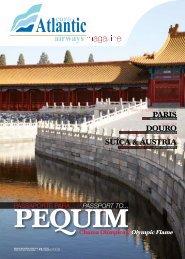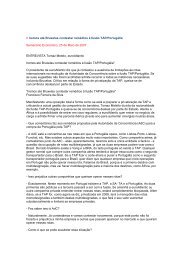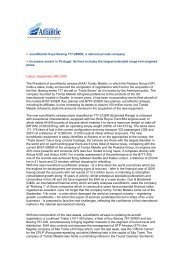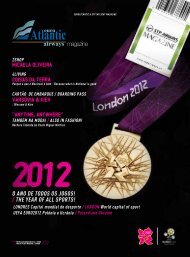pORTUGAL - Euro Atlantic Airways
pORTUGAL - Euro Atlantic Airways
pORTUGAL - Euro Atlantic Airways
You also want an ePaper? Increase the reach of your titles
YUMPU automatically turns print PDFs into web optimized ePapers that Google loves.
STOP OVER<br />
p 32<br />
MONSANTO»<br />
A “aldeia mais portuguesa de Portugal” mantém até hoje toda a sua originalidade com as casas construídas em cima de rochedos graníticos<br />
“The most Portuguese village in Portugal” keeps until today its originality with houses built on the top of granite rocks<br />
dos seus monumentos mais populares, repousa<br />
o “troféu”: um galo de prata.<br />
À CONqUISTA DO MUNDO Para<br />
quem chega a Monsanto a tarefa de visitar<br />
a aldeia surge como um desafio. Inclinação<br />
acentuada, presença forte de pedra granítica<br />
e ruas labirínticas. Não é por acaso que<br />
vem de longe a máxima “quem conquista<br />
Monsanto, conquista o Mundo”. Mas vale a<br />
pena. Acredite. A recompensa encontra-se a<br />
cada esquina dobrada e atinge o seu expoente<br />
máximo aos 758 metros de altitude. É<br />
nessa altura que a aldeia “agradece” a visita,<br />
permitindo contemplar a extraordinária paisagem<br />
em redor que, se a meteorologia ajudar,<br />
alcança Espanha.<br />
A presença humana no local data do paleolítico,<br />
existindo registos de que a aldeia terá sido<br />
habitada por romanos, além de vestígios de<br />
passagem árabe e visigótica. No que respeita<br />
aos monumentos, e exceptuando as obras<br />
de cariz militar, como o castelo, as muralhas<br />
e a Torre do Relógio ou Lucano, a arquitectura<br />
é essencialmente de natureza religiosa.<br />
Neste particular, merece observação atenta a<br />
Igreja de São Salvador, cuja fachada remonta<br />
ao século XVIII, possuindo no interior imagens<br />
de elevado valor artístico, assim como a Capela<br />
de São Miguel, um templo românico localizado<br />
no ponto mais alto da aldeia, entre o<br />
Castelo e a torre de vigia medieval, apelidada<br />
de Torre do Pião.<br />
MARAFONAS AO SOM DO ADUFe O<br />
artesanato é outro dos ex-libris de Monsanto.<br />
Além do seu próprio instrumento musical,<br />
CONqUeRING The WORLD Those<br />
who arrive at Monsanto face a challenge if<br />
they want to visit it. Tilt sharp, strong presence<br />
of granite stone and labyrinthine streets.<br />
it’s not by chance that one can hear the old<br />
saying “who conquers Monsanto, conquers<br />
the world.”<br />
But it’s worthwhile. Believe it. There’s a reward<br />
in every corner and reaches 758 meters on its<br />
highest point. At that point the village actually<br />
thanks your visit by letting you admire its<br />
incredible surrounding landscape that, if the<br />
weather is fine, it spreads to Spain.<br />
The human presence in the area is traced<br />
back to the Paleolithic era, and there is also<br />
archaeological evidence that the village was<br />
inhabited by Romans, as well as evidence of<br />
Visigoth and Arabian occupation. with the<br />
exception of military buildings as the Castle,<br />
the walls and the Clock Tower or lucano, the<br />
architecture is mainly religious as far as monuments<br />
are concerned. One must take a closer<br />
look to São Salvador Church, whose facade<br />
dates from the 18th century, having inside<br />
images of great artistic value, as well as St.<br />
Michael’s Chapel, a roman temple located at<br />
the highest point of the village, between the<br />
Castle and a watch point of the middle ages,<br />
named Pin Tower.<br />
RAG-DOLLS AT The SOUND OF<br />
ADUF The handcraft is another master<br />
piece of Monsanto. Besides its unique musical<br />
instrument, the aduf [a square tambourine],<br />
which nowadays is still played by a local<br />
group named “Adufeiras de Monsanto”, the<br />
village also has another well-known handcraft<br />
o adufe, que ainda hoje é tocado por um grupo<br />
local designado Adufeiras de Monsanto, a aldeia<br />
possui nas Marafonas a sua peça mais conhecida.<br />
Tratam-se de bonecas feitas em pano sob<br />
uma cruz de madeira, com a particularidade de<br />
não possuírem olhos, boca, nariz ou ouvidos.<br />
Com forte carga simbólica, estas bonecas estão<br />
ligadas ao culto da fertilidade e reza a lenda que<br />
devem ser colocadas debaixo da cama na noite<br />
de núpcias como amuleto para o casal. Dadas as<br />
suas características, os noivos têm a garantia de<br />
que nada do que se passa na intimidade é visto<br />
ou escutado.<br />
Os adufes e as Marafonas são elementos fundamentais<br />
na Festa das Cruzes, uma celebração<br />
local que tem lugar em Maio, no Castelo, e cuja<br />
origem remonta à Lenda do Cerco, apenas uma<br />
das várias que estão associadas a esta aldeia histórica.<br />
Para conhecê-las ao pormenor não hesite<br />
na próxima visita em perguntar aos moradores,<br />
autênticas autoridades na matéria.<br />
piece: the rag-dolls. These dolls are made of cloth<br />
on a cross of wood and they have a particularity:<br />
they have no eyes, mouth, nose or ears. Bearing<br />
a strong symbolic meaning, these dolls are linked<br />
to the fertilization cult and according to the legend<br />
they must be placed under the bed on the wedding<br />
night as a good luck charm for the couple.<br />
Due to their characteristics, the grooms are secure<br />
that nothing about their intimacy is seen or heard.<br />
Rag-dolls and aduf are crucial elements in the Festival<br />
of the holy Cross, a local celebration which is<br />
held in May in the Castle. its origin is connected<br />
with the legend of the Siege, one of many legends<br />
linked to this historical village. To know them in detail<br />
don’t hesitate to ask around in your next visit.<br />
After all the inhabitants are the authentic authorities<br />
on the subject.<br />
p 33













